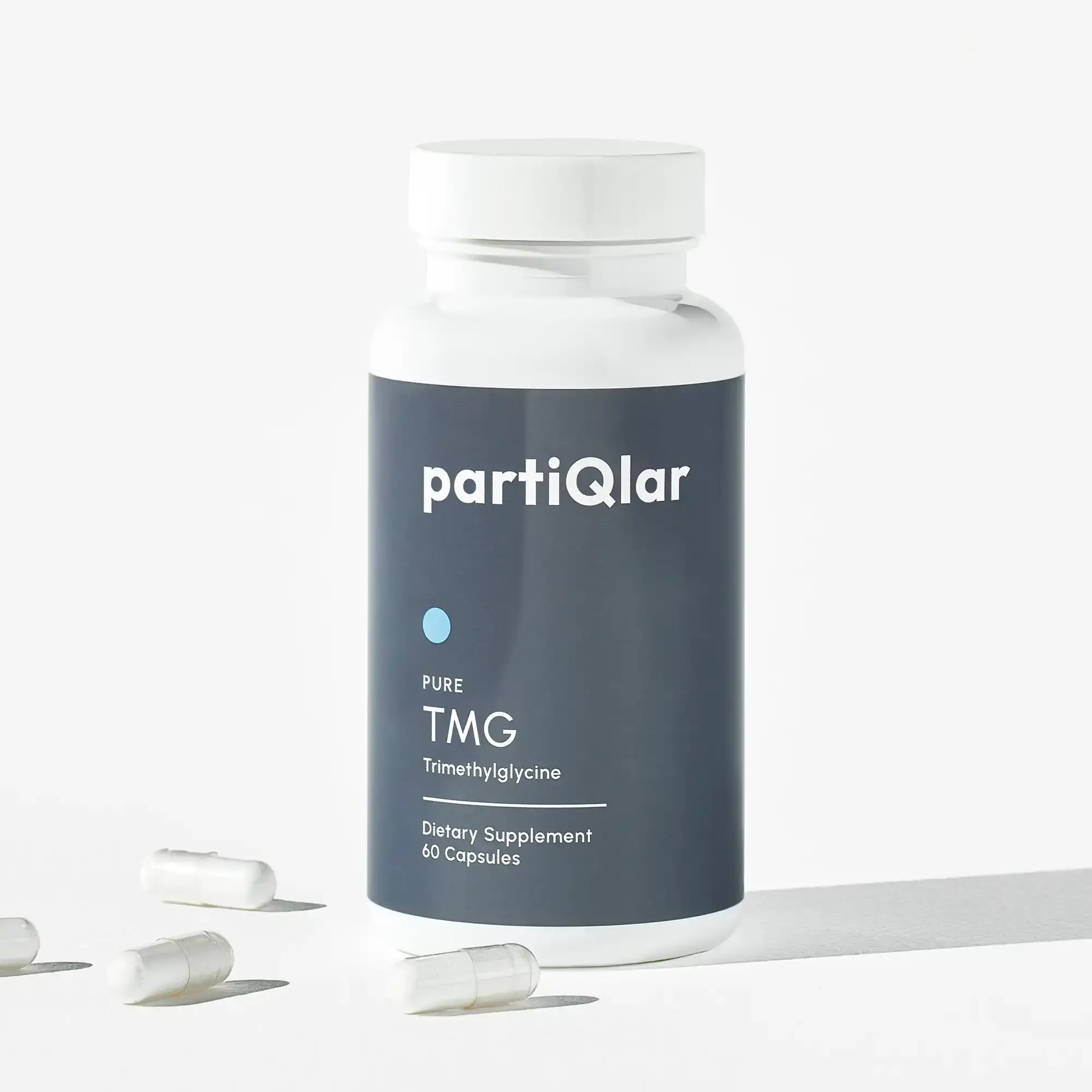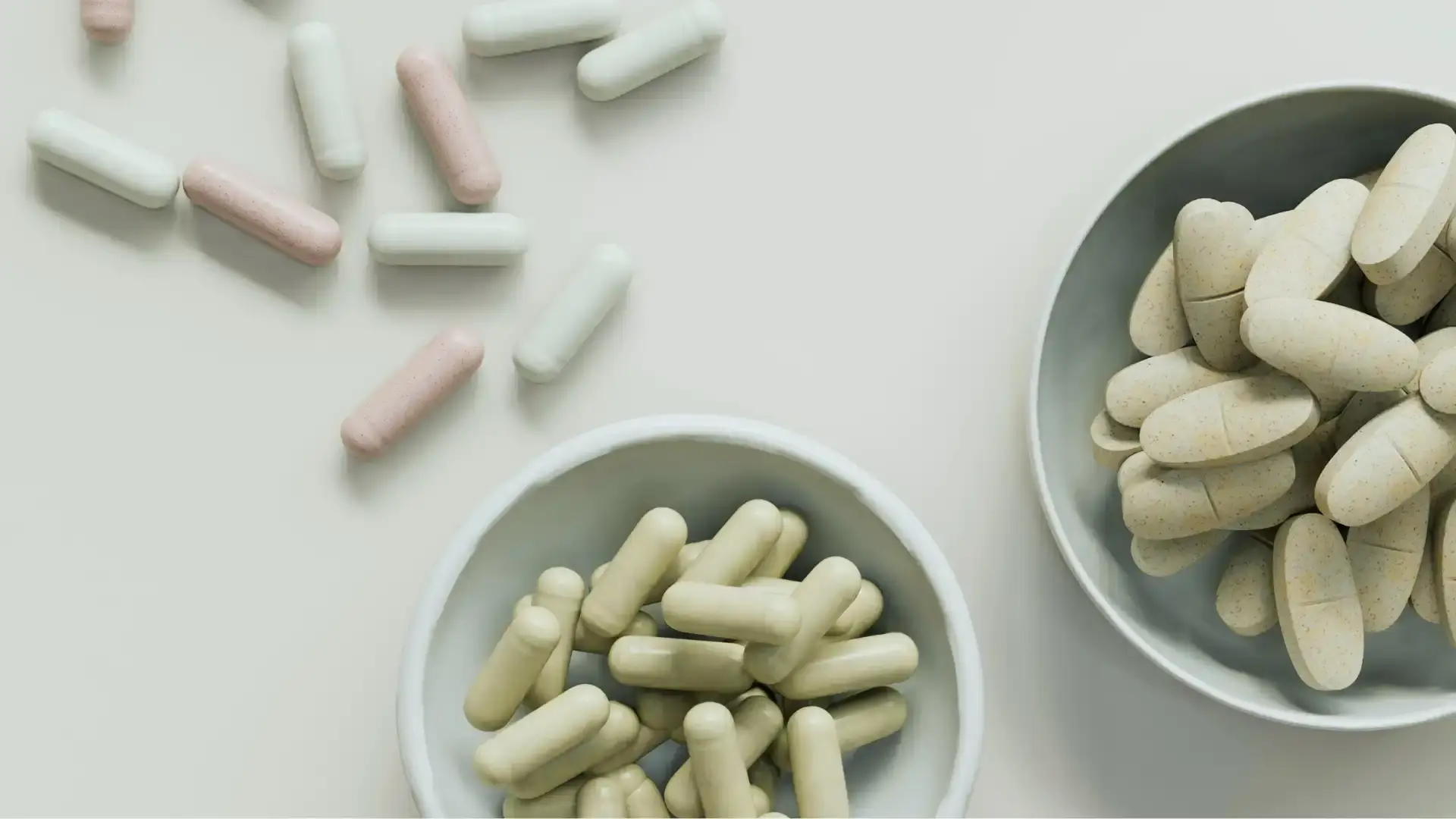NMN supplements typically show noticeable effects, such as increased energy and focus, within a few days to weeks, while long-term benefits like improved metabolism and anti-aging effects may take months.
How Much TMG Should I Take? Dosage Guide Explained
- Lifestyle
- April 17, 2025
- Gabriella J., partQlar

Related Product
Key takeaways:
- The safest way to take TMG supplements is to start low (500 mg daily) and increase the intake if no side effects are felt.
- The individual intake depends on your desired outcomes, genetics, and pre-existing medical conditions.
- The benefits of TMG are generally noticeable after a few weeks of daily usage.
- TMG dosage of up to 4000 mg/day is generally safe.
Trimethylglycine (TMG) is a foundational nutrient in your longevity journey. Naturally found in foods like beets, spinach, and whole grains, TMG contains three methyl groups, which are tiny chemical structures made of one carbon and three hydrogen atoms (1).
Since TMG donates methyl groups, meaning it gives these structures to other molecules, such as proteins or DNA, in a process called methylation. This donation of methyl groups supports vital functions like DNA repair and brings balance to numerous behind-the-scenes systems in your body (2).
Another reason why you should take TMG is homocysteine control. Homocysteine is an amino acid that helps with protein production. However, high levels of homocysteine put a strain on your heart and brain. It’s even linked with heart disease and high blood pressure (3). TMG is known for reducing and controlling homocysteine levels (4).

How Much TMG Should I Take?
| Desired outcome | TMG intake | Why? |
| General wellness | 500-800 mg/day | A low TMG intake contributes to homocysteine conversion into methionine, which is a building block for proteins, helping your body maintain harmony (5) |
| Lower homocysteine levels | 1500-3000 mg/day | A higher TMG intake yields significant reductions in homocysteine, some studies have found a reduction of 12-20% in 6 weeks (6). |
| Improved liver function | 1000-2000 mg/day | A moderate amount of TMG reduces the chance of hepatic steatosis (fatty liver) (7). |
| Enhanced athletic performance | 500-2000 mg/day (dependant on age and physical activity) | Low-to-moderate amounts of TMG have reduced recovery times and improved sprint performance, muscular strength, and multiple other athletic indicators (8). |
Dosage by Individual Needs
TMG Supplement Intake By Age And Weight
TMG is generally considered safe, however, young adults and seniors should take more precautions when choosing this supplement. Young adults should first do blood tests to determine whether they need to supplement TMG. Older adults with methylation issues may benefit from TMG supplementation, but it should be personalized and closely monitored, especially when combining it with other methyl donors (10).
Currently, no studies on TMG have adjusted their methodologies by body weight. We currently do not recommend increasing the supplement dose solely because of your body weight. It’s best to adjust the amount based on your observations – the effects you feel (including side effects) after a few weeks of usage.
TMG Supplements For Various Health Conditions
As we have established before, Trimethylglycine (TMG) can support and improve liver function. According to the same study, people with both alcohol-induced and metabolic-induced liver diseases can take TMG to reduce the damage to this vital organ (11).
There is another condition in which TMG is the key player. Methylenetetrahydrofolate reductase (MTHFR) may sound like a spell from Harry Potter, but it plays a crucial role in methylation. MTHFR is a gene that produces an enzyme, meant to process folate (vitamin B9) and maintain healthy homocysteine levels (12).
Approximately 24% of people have mutations of the MTHFR gene (13). These mutations can result in elevated homocysteine levels, reduced methylation capacity and higher risk of cardiovascular, neurological and inflammatory conditions.
TMG supplements are used to reduce the risks caused by this gene mutation. In order to retain healthy homocysteine levels, TMG bypasses the MTHFR gene and uses a different solution: the betaine-homocysteine methyltransferase (BHMT).
This way, the supplement acts as a methyl donor again and gives homocysteine a methyl group, which then turns homocysteine into methionine – a tissue-building amino acid.
You Can Take TMG With Other Supplements
Many people like to supplement TMG together with folate and B12 vitamins. These three together play a vital role in the methylation process. Folate and betaine (TMG) significantly lower homocysteine levels, while vitamin B12 further contributes to general well-being (14).
It’s quite common to try TMG together with NMN for longevity purposes. These supplements both contribute to DNA repair (15), which shows a synergic relationship between the two, contributing to your well-being with dual power.
Is TMG Safe? Side Effects & Risks
Trimethylglycine (TMG) supplements are generally considered safe for most people, especially when taken at recommended dosages. However, like any bioactive compound that influences the methylation process and homocysteine levels, there are things to watch out for.
Common Side Effects of TMG
At typical dosages used for supporting healthy homocysteine levels or enhancing methylation, TMG supplementation tends to be well-tolerated. However, high amounts of TMG (>4000 mg/day) might cause some mild side effects, such as stomach discomfort, nausea, mild fatigue or headaches (16).
Who Should Avoid or Limit TMG
While many users experience the benefits of TMG supplements without issue, some groups should use caution or avoid it altogether unless advised by a healthcare provider:
- People with kidney disease (due to possible effects on urea metabolism).
- Those with high cholesterol, especially if not well managed, as doses above 4000 mg/day have been linked to higher cholesterol and LDL.
As with any supplement use, we recommend consulting with your healthcare provider first. We especially advise performing blood tests before and after using TMG supplements. This will help you track your progress better and you will lead a far more fulfilling longevity journey!
Conclusion
TMG supplements can be a valuable tool for supporting methylation and maintaining healthy homocysteine levels, but only when taken with intention. Most people do well starting at 500–750 mg per day and adjusting gradually based on personal response.
There’s no one-size-fits-all answer. Your ideal dosage of TMG supplements depends on your goals, health status, and how your body responds over time. Pair it with the right nutrients, take it consistently, and track your results. Consulting a medical professional is advised.
Start smart, stay steady, and let TMG do the heavy lifting behind the scenes.
Explore Products
Related Articles
Resveratrol, a powerful phytochemical found in foods like red grapes and dark chocolate, supports heart health and longevity, with its benefits amplified when combined with NMN to boost NAD+ levels in the heart and muscles.
This blog post discusses the FDA's recent decision to no longer classify NMN as a dietary supplement, examining the implications for its availability and safety in the market.



